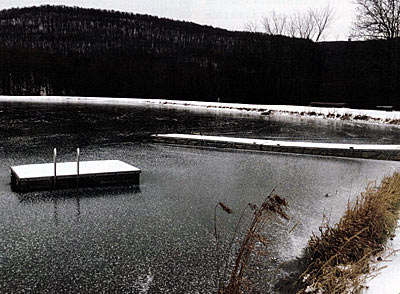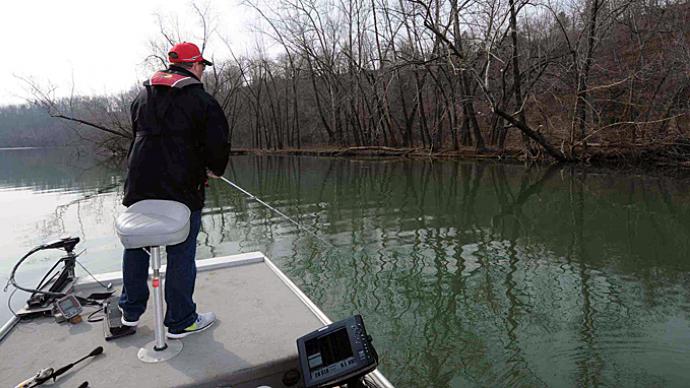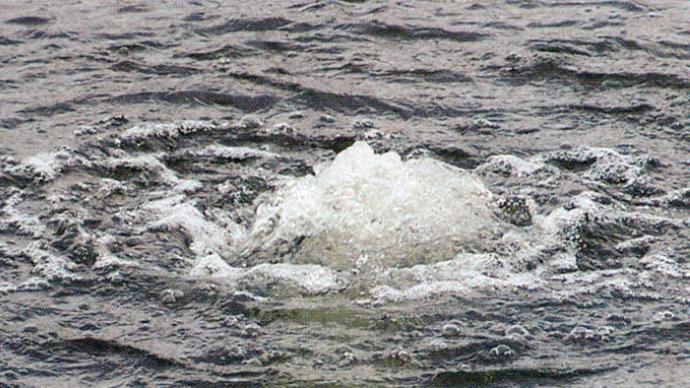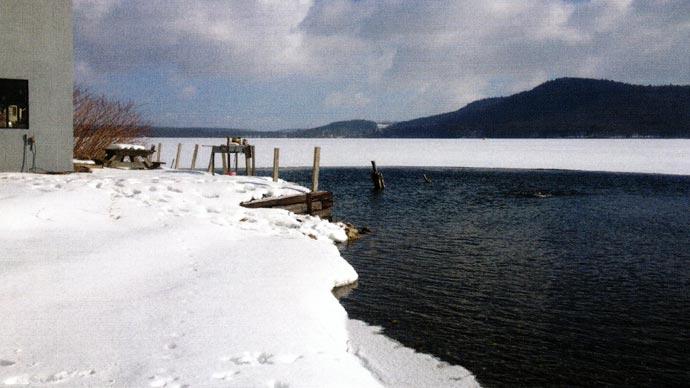
Winter came early to the Cornwell ranch pond last year. November 12th is the earliest I can ever remember having full ice on local ponds. I do remember one year when I was ice fishing on 3" of hard clear ice on Thanksgiving Day, so this early freeze was about two weeks earlier. In any event, a strange, cold, Arctic storm from Siberia raced across the country last year and pulled down record cold. Most of the nation from Texas and Tallahassee to Toledo and Tupper Lake was sent into the frigid ice box.
As I watched and listened to the conversation on Bob Lusk's Wednesday "Pond Boss Facebook-Live" broadcast tonight, I was struck by how differently ponds and fish respond to a cold weather snap like this, depending on where they are geographically located. Then I thought a layer deeper (pun intended)—the fundamental principles of how water behaves are the same no matter the location. What is different is the duration of the cold, and the types offish exposed to the cold change. Now may be a good time to have a brief discussion about what is happening as your pond eases (or crashes) into winter.
In broad terms, pond water temperature slowly follows air temperature. Surface water interacts with air, and then the water is either cooled or warmed, depending on the air temperature trend. Water is stingy with its heat, giving it up and taking heat in slowly. Have you ever seen smoke on the water? The pond is steaming because the pond is warm and the air is cool. Fog results as water gives up its heat.
As water temperature changes, its density will also change. The densest water is 4°C or about 39°F. Dense water sinks and less dense water slowly rises. In a cooling trend, such as going into winter, the falling air temperature cools the surface water and the cooler water sinks because it is denser. The water continues to cool and sink; eventually the entire water column will temporarily be the same temperature. During this time, wind can mix the entire pond, this phenomenon is called fall turnover. Most large lakes (in the northeast) turn over twice a year, once in spring and once in fall. These lakes are termed dimictic. However, many small ponds turn over more often because density differences can be overcome by fierce winds or storm events that involve hail. My pond (1.3 acres in upstate New York and 10' deep) is thoroughly mixed from top to bottom all year when it is ice free. It may stratify for a few days in the late spring, but then a warm, southwest wind will destabilize the whole water column and mix it up. Why? The pond is too small and shallow.
Now, what happens next depends on where you live. In the north, ice-over can come rapidly when the temperature drops and stays below freezing. Last night the temperature was 3°F and has remained below freezing. The water was 32°F or 0°C when it froze. Now, the pond has ice and is effectively capped and stable, with no wind accessing the water to continue turnover. This allows a density stratification to form— and it is inverse to what would happen in the summer. The densest water is still at the bottom. Period. Above that is 3°C water, then 2°C water, then 1°C water, and on top of that is the ice at 0°C and that ice is FLOATING because it is the least dense water! Yep, ice floats just like in a glass of sweet tea in the south. So, in the winter we say the pond is inversely stratified.
Remember stingy heat? This cool down and ice formation process takes longer when the pond is deeper, because more water must be cooled. Sometimes the fetch (orientation to the wind) plays a role. A windy lake takes longer to freeze because waves physically disrupt ice formation. Ice forms best on calm nights with no wind. A very deep pond or lake gives up (winter) and receives (spring) heat more slowly because (by volume) a small percentage of the lake is exposed to the atmosphere. Think about trying to cool your iced tea quickly with one ice cube or a whole bunch of crushed ice. The crushed ice cools it faster because of increased surface area. A larger lake has a smaller surface area exposed to the atmosphere, which results in slower heating or cooling.
A more southern pond may cool to 2°C (or 35°F) but never actually freeze (0°C or 32°F), and no ice will form. When this happens, wind will continue to mix the pond at that temperature, and the pond will never stabilize like it does under full ice. This happens frequently in a deep south cold snap and in ponds in zones where the winter temperatures hover between 33-40°F for extended periods of time. The 35°F water will mix from top to bottom uniformly with the wind. That's cold, and both shallow ponds and ponds with a long fetch exposed to the prevailing wind will cool and mix faster. That might mean trouble for warm water fish like tilapia in the south and a fish like an alewife (a herring) in the north. These conditions of cold water mixing all the way to the bottom, without a warmer water refuge, may lead to significant die-offs of temperature sensitive fish. Some lakes are famous for these types of die-offs. I remember one year watching thousands of alewives dying under clear ice in a local lake. Winter had come late that year and the deep lake mixed for a month before ice over. That year the density of alewife was high, leading to increased competition for food, and resulting in smaller, less-fit alewife going into the winter. These smaller fish were not in great shape, with less fish oil in their bodies than normal. Then, they got a triple whammy of a strange winter with late (or no) ice, chilling the water to a lower than normal temperature (like 2°C from top to bottom in all 150' of lake water). That combination was lethal for a large number of these shad-like fish. A similar thing happens in the south, when a cold snap brings water temperature to lethal temperatures for susceptible fish species. If the water temperature drops to the 50°F or below, Tilapia Mozambique will die. Similar mortality events can happen with threadfin and even some of the largest gizzard shad. Threadfins don't like water temperatures in the low 40s, and big gizzards don't like it when the water temperatures quickly drop into the high 30s. However, there are several lakes in New York (and some very deep ponds) that successfully over winter gizzard shad. These lakes typically form ice, stratify, and have warm, 4°C water at the bottom in the winter. This warm water refuge at the bottom allows these shad to over-winter.
The take home message here is when a fast, arctic cold front causes water temperatures to dive quickly, severe initial winter mortality may result with your warm water fish. And, this phenomenon may be more severe with less fit individuals resulting from a high pond density (think small and stunted fish). Once ice is established, temperatures stabilize to normal over winter conditions and the rate of mortality will remain normal. Southern lakes and ponds are more susceptible to this problem because they remain ice free for longer periods in the winter than northern ponds. My pond is already immune to this problem because it is now ice covered and insulated from the next roaring Arctic front.
On the downside, it will be susceptible to other problems including winterkill, because there is a prolonged period, from now to the end of March, where water will not interact with the air. This is a whole other topic covered many times in these pages.
What drives natural mixing in your pond? Changing water temperature results in density differences in the water column. Denser water sinks, less dense water rises, and when the density difference is small, mixing is usually driven by wind. Windy arctic cold snap? This phenomenon happens faster and maybe more severely—and your fish may hate it. What to do? Not much.
Stoke the fire, have a sip of brandy, and plan to restock with more cold tolerant fish. That's a pretty cold statement, but so is the weather, over which we have zero degree of control.
Reprinted with permission from Pond Boss Magazine



